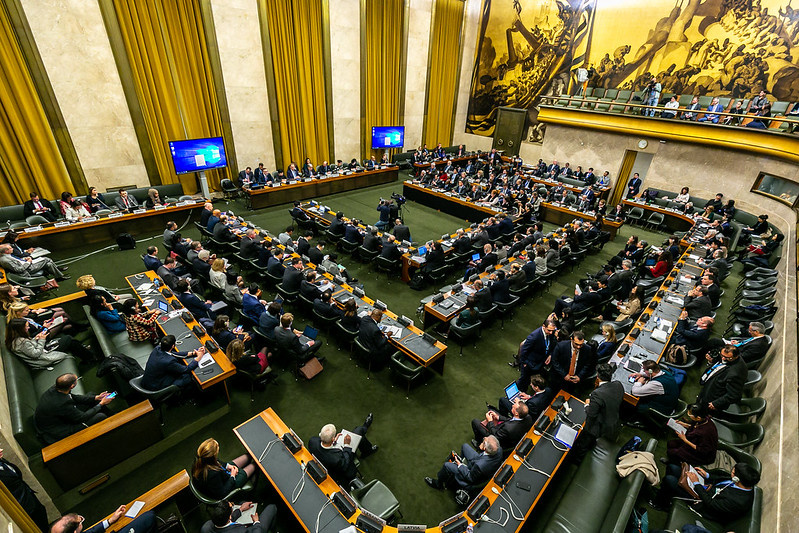Fil d'Ariane

LE PALAIS DES NATIONS ACCUEILLE UNE RÉUNION SUR LES MINES ANTI-VÉHICULES LE 6 NOVEMBRE (en anglais)

An open-ended one-day meeting on mines other than anti-personnel mines (MOTAPM), also known as anti-vehicle mines (AVMs), will take place on Friday, 6 November 2015, in Conference Room XII of the Palais des Nations in Geneva. The meeting is organized by the United Nations Office for Disarmament Affairs (UNODA), the United Nations Mine Action Service (UNMAS), and the Geneva International Centre for Humanitarian Demining (GICHD).
MOTAPM or anti-vehicle mines constitute a long-standing humanitarian concern. Their humanitarian and development impact is significant as they represent a grave threat both during and after the conflict to civilians, humanitarian aid workers and peacekeepers around the world. In particular, MOTAPM can significantly hamper the delivery of humanitarian aid to vulnerable populations, impede the return of refugees and internally displaced people, and hinder recovery and development of affected communities. In some countries, anti-vehicle mines have had even greater adverse effects than anti-personnel mines.
Existing restrictions in International Humanitarian Law on the use of MOTAPM are widely considered to be inadequate in responding to the continuing humanitarian and developmental impact of these weapons. Although a range of measures have been considered on their use and design, this issue remains unresolved.
Against this background, in his statement to the 2014 Meeting of States parties to the Convention on Certain Conventional Weapons (CCW), the United Nations Secretary-General, called on States to “further explore ways to ensure that anti-vehicle mines no longer harm civilians, impede the delivery of humanitarian aid or obstruct social and economic development”.
The one-day meeting is aimed at understanding the hazards arising from the use of MOTAPM, discussing possible measures to address these hazards and exploring options for future work on this issue.
| 1. OPENING SESSION |
1.1 Opening addresses by Joint Chairs (UNMAS, UNODA, GICHD)
1.2 Evolution of military doctrine on the use of MOTAPM
1.3 Current status of International Humanitarian Law (IHL) on the use of MOTAPM
| 2. Challenges faced by affected states |
2.1 Scope of the problem
2.2 The humanitarian and developmental impact of MOTAPM use
2.3 Difficulties in detection and clearance of MOTAPM
2.4 Challenges for affected states
| 3. Measures to address the humanitarian impact of AVM (MOTAPM) |
3.1 Design of existing AVM and possible future developments
3.2 Recent incidents and measures to mitigate impact and improve quality of reporting
3.3 A perspective from the field on clearance of AVM
3.4 Cooperation and Assistance for clearance of AVM
3.5 Measures taken on a national basis by states in addition to existing IHL
| 4. Future activities and possible way forward |
4.1 Possible additions to or clarification of existing IHL
4.2 Background to and current status of issue within CCW framework
4.3 Future options within and outside CCW framework
| 5. Closing of Meeting |
5.1 Closing Address
Friday 6 November 2015
| Time | Topic | Presenters |
| 10.00 – 11.00 | Opening Session Opening addresses by Joint Chairs Evolution of military doctrine on the use of MOTAPM Current status of International Humanitarian Law (IHL) on the use of MOTAPM | Chairs: Joint Chairs UNODA, UNMAS, GICHD Brigadier William Sowry, AM, CSC, Head Australian Defence Staff – London Mr. Lou Maresca, Legal Adviser, ICRC |
| 11.00 – 13.00 | Challenges faced by affected states Scope of the problem The humanitarian and developmental impact of MOTAPM use Difficulties in detection and clearance of MOTAPM Challenges for affected states | Chair: Chief UNMAS Geneva, Mr. Bruno Donat Mr. Paul Grimsley, Chief, Arms & Ammunition, UNMAS Libya Ms. Rachel Irwin, Senior Researcher, SIPRI Mr. Tim Lardner, Chief, UNMAS South Sudan Mr. Nazir Ahmad Foshanji, Permanent Mission of Afghanistan Mr. Cyer Mayar Cyerdit, Permanent Mission of South Sudan |
| 13.00 – 14.00 | Lunch | Sandwiches served outside Conference Room XII |
| 14.00 – 15.30 | Measures to address the humanitarian impact of AVM use Design of existing AVM and possible future developments Recent incidents and measures to mitigate impact and improve quality of reporting A perspective from the field on clearance of AVM Cooperation and assistance for clearance of AVM Measures taken on a national basis by states in addition to existing IHL | Chair: Director GICHD, Ambassador Stefano Toscano Mr. Colin King, Director, Fenix Insight Ltd Mr. Guy Rhodes, Director of Operations, GICHD Mr. Calvin Ruysen, Desk Officer, HALO Mr. Mark Versteden, Permanent Mission of the Netherlands Mr. Bantan Nugroho, CCW Implementation Support Unit |
| 15.30 – 16.15 | Future activities and possible way forward Background to and current status of issue within CCW framework, options for moving forward, and possible additions to or clarification of existing IHL Future options within and outside the CCW framework | Chair: UNODA, Mr. Peter Kolarov Mr. Peter Herby Discussion |
| 16.15 – 16.30 | Closing Address | Director General, UNOG, Mr. Michael Møller |
For use of the information media; not an official record
DC15/047E
